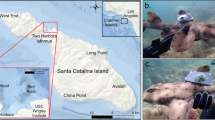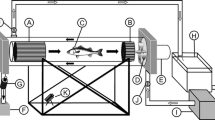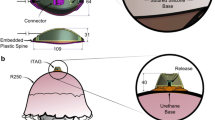Abstract
Knowing how often animals engage in different behaviors and their energetic costs may explain why animals behave the way they do in the wild. This study sought to investigate the relationship between the frequency of various swimming behaviors and their associated energetic costs (oxygen consumption rates) in situ for juvenile lemon sharks (Negaprion brevirostris). Behaviors were identified for captive animals and remotely observed for animals in the wild with accelerometers, and oxygen consumption rates of behaviors were estimated using acceleration-calibrated relationships. Lemon sharks rested infrequently (4.3% of deployment), and the occurrence of active swimming behaviors was inversely related to their respective oxygen consumption rates. Furthermore, time of day and tide state influenced when lemon sharks exhibited active swimming behaviors – but not resting – such that sharks were most active during the day on flooding tides. Oxygen consumption rates also differed across and within different behaviors with time of day and tide state, although mean oxygen consumption rates were highest on daytime flooding tides and uniformly reduced across all other diel and tide combinations. Despite variation in oxygen consumption rates, however, lemon shark activity occurred at 32.3–35.6% of their aerobic metabolic scope. These data do not provide a clear oxygen consumption basis for swimming behaviors observed in situ, which may have been masked by potentially stronger ecological drivers (e.g., predator-prey dynamics). However, these data are relevant to linking behavioral modifications to changes in energy use that shows much promise for addressing conservation issues in fishes.



Similar content being viewed by others
References
Aebischer NJ, Robertson PA, Kenward RE (1993) Compositional analysis of habitat use from radio-tracking data. Ecology 74(5):1313–1325. https://doi.org/10.2307/1940062
Auer SK, Salin K, Rudolf AM, Anderson GJ, Metcalfe NB (2015) The optimal combination of standard metabolic rate and aerobic scope for somatic growth depends on food availability. Funct Ecol 29:479–486. https://doi.org/10.1111/1365-2435.12396
Barnett A, Payne NL, Semmens JM, Fitzpatrick R (2016) Ecotourism increases the field metabolic rate of whitetip reef sharks. Biol Conserv 199:132–136. https://doi.org/10.1016/j.biocon.2016.05.009
Boisclair D, Leggett WC (1989) The importance of activity in bioenergetics models applied to actively foraging fishes. Can J Fish Aquat Sci 46:1859–1867. https://doi.org/10.1139/f89-234
Boisclair D, Sirois P (1993) Testing assumptions of fish bioenergetics models by direct estimation of growth, consumption, and activity rates. Trans Am Fish Soc 122:784–796. https://doi.org/10.1577/1548-8659(1993)122<0784:TAOFBM>2.3.CO;2
Bouyoucos IA, Suski CD, Mandelman JW, Brooks EJ (2017a) Effect of weight and frontal area of external telemetry packages on the kinematics, activity levels and swimming performance of small-bodied sharks. J Fish Biol 90:2097–2110. https://doi.org/10.1111/jfb.13290
Bouyoucos IA, Montgomery DW, Brownscombe JW, Cooke SJ, Suski CD, Mandelman JW, Brooks EJ (2017b) Swimming speeds and metabolic rates of semi-captive juvenile lemon sharks (Negaprion brevirostris, Poey) estimated with acceleration biologgers. J Exp Mar Biol Ecol 486:245–254. https://doi.org/10.1016/j.jembe.2016.10.019
Bouyoucos IA, Suski CD, Mandelman JW, Brooks EJ (2017c) The energetic, physiological, and behavioral response of lemon sharks (Negaprion brevirostris) to simulated longline capture. Comp Biochem Physiol A Mol Integr Physiol 207:65–72. https://doi.org/10.1016/j.cbpa.2017.02.023
Brett JR (1964) The respiratory metabolism and swimming performance of young sockeye salmon. J Fish Res Board Can 21:1183–1226. https://doi.org/10.1139/f64-103
Brooks EJ, Sims DW, Danylchuk AJ, Sloman KA (2013) Seasonal abundance, philopatry and demographic structure of Caribbean reef shark (Carcharhinus perezi) assemblages in the north-east Exuma sound, the Bahamas. Mar Biol 160:2535–2546. https://doi.org/10.1007/s00227-013-2246-0
Brown DD, Kays R, Wikelski M, Wilson R, Klimely AP (2013) Observing the unwatchable through acceleration logging of animal behavior. Anim. Biotelemetry 1:20. https://doi.org/10.1186/2050-3385-1-20
Brownscombe JW, Gutowsky LFG, Danylchuk AJ, Cooke SJ (2014) Foraging behaviour and activity of a marine benthivorous fish estimated using tri-axial accelerometer biologgers. Mar Ecol Prog Ser 505:241–251. https://doi.org/10.3354/meps10786
Brownscombe JW, Cooke SJ, Danylchuk AJ (2017) Spatiotemporal drivers of energy expenditure in a coastal marine fish. Oecologia 183:689–699. https://doi.org/10.1007/s00442-016-3800-5
Bullock RW, Guttridge TL, Cowx IG, Elliott M, Gruber SH (2015) The behaviour and recovery of juvenile lemon sharks Negaprion brevirostris in response to external accelerometer tag attachment. J Fish Biol 87:1342–1354. https://doi.org/10.1111/jfb.12808
Bushnell PG, Lutz PL, Steffensen JF, Oikari A, Gruber SH (1982) Increases in arterial blood oxygen during exercise in the lemon shark (Negaprion brevirostris). J Comp Physiol B 147:41–47. https://doi.org/10.1007/BF00689288
Clark TD, Donaldson MR, Pieperhoff S, Drenner SM, Lotto A, Cooke SJ, Hinch SG, Patterson DA, Farrell AP (2012) Physiological benefits of being small in a changing world: responses of Coho salmon (Oncorhynchus kisutch) to an acute thermal challenge and a simulated capture event. PLoS One 7:e39079. https://doi.org/10.1371/journal.pone.0039079
Cooke SJ, Brownscombe JW, Raby GD, Broell F, Hinch SG, Clark TD, Semmens JM (2016) Remote bioenergetics measurements in wild fish: opportunities and challenges. Comp Biochem Physiol A Mol Integr Physiol 202:23–37. https://doi.org/10.1016/j.cbpa.2016.03.022
Cortés E, Gruber SH (1990) Diet, feeding habits and estimates of daily ration of young lemon sharks, Negaprion brevirostris (Poey). Copeia 1990:204–218. https://doi.org/10.2307/1445836
Danylchuk AJ, Suski CD, Mandelman JW et al (2014) Hooking injury, physiological status and short-term mortality of juvenile lemon sharks (Negaprion bevirostris) following catch-and-release recreational angling. Conserv Physiol 2:cot036. https://doi.org/10.1093/conphys/cot036
De’ath G, Fabricius KE (2000) Classification and regression trees: a powerful yet simple technique for ecological data analysis. Ecology 81:3178–3192. https://doi.org/10.1890/0012-9658(2000)081[3178:CARTAP]2.0.CO;2
Dowd WW, Brill RW, Bushnell PG, Musick JA (2006) Standard and routine metabolic rates of juvenile sandbar sharks (Carcharhinus plumbeus), including the effects of body mass and acute temperature change. Fish Bull 104:323–331
Gleiss AC, Gruber SH, Wilson RP (2009) Multi-channel data-logging: towards determination of behaviour and metabolic rate in free-swimming sharks. In: Nielsen JL, Arrizabalaga H, Fragoso N, Hobday A, Lutcavage M, Sibert J (eds) Tagging and tracking of marine animals with electronic devices. Springer, Dordrecht, Netherlands, pp 211–228. https://doi.org/10.1007/978-1-4020-9640-2_13
Gleiss AC, Dale JJ, Holland KN, Wilson RP (2010) Accelerating estimates of activity-specific metabolic rates in fishes: testing the applicability of acceleration data-loggers. J Exp Mar Biol Ecol 385:85–91. https://doi.org/10.1016/j.jembe.2010.01.012
Graham JB, Dewar H, Lai NC, Lowell WR, Arce SM (1990) Aspects of shark swimming performance determined using a large water tunnel. J Exp Biol 151:175–192
Gruber SH, Nelson DR, Morrissey JF (1988) Patterns of activity and space utilization of lemon sharks, Negaprion brevirostris, in a shallow Bahamian lagoon. Bull Mar Sci 43:61–76
Guttridge TL, Gruber SH, Franks BR, Kessel ST, Gledhill KS, Uphill J, Krause J, Sims DW (2012) Deep danger: intra-specific predation risk influences habitat use and aggregation formation of juvenile lemon sharks Negaprion brevirostris. Mar Ecol Prog Ser 445:279–291. https://doi.org/10.3354/meps09423
Harborne AR, Talwar B, Brooks EJ (2016) The conservation implications of spatial and temporal variability in the diurnal use of Bahamian tidal mangrove creeks by transient predatory fishes. Aquat Conserv Mar Freshwat Ecosyst 26:202–211. https://doi.org/10.1002/aqc.2538
Hasler CT, Midway SR, Jeffrey JD, Tix JA, Sullivan C, Suski CD (2016) Exposure to elevated pCO2 alters post-treatment diel movement patterns of largemouth bass over short time scales. Freshw Biol 61:1590–1600. https://doi.org/10.1111/fwb.12805
Hussey NE, DiBattista JD, Moore JW, Ward EJ, Fisk AT, Kessel S, Guttridge TL, Feldheim KA, Franks BR, Gruber SH, Weideli OC, Chapman DD (2017) Risky business for a juvenile marine predator? Testing the influence of foraging strategies on size and growth rate under natural conditions. Proc R Soc B Biol Sci 284:20170166. https://doi.org/10.1098/rspb.2017.0166
Kawabe R, Kawano T, Nakano N, Yamashita N, Hiraishi T, Naito Y (2003) Simultaneous measurement of swimming speed and tail beat activity of free-swimming rainbow trout Oncorhynchus mykiss using an acceleration data-logger. Fish Sci 69:959–965. https://doi.org/10.1046/j.1444-2906.2003.00713.x
Killen SS, Marras S, Metcalfe NB, McKenzie DJ, Domenici P (2013) Environmental stressors alter relationships between physiology and behaviour. Trends Ecol Evol 28:651–658. https://doi.org/10.1016/j.tree.2013.05.005
Lear KO, Whitney NM, Brewster LR, Morris JJ, Hueter RE, Gleiss AC (2017) Correlations of metabolic rate and body acceleration in three species of coastal sharks under contrasting temperature regimes. J Exp Biol 220:397–407. https://doi.org/10.1242/jeb.146993
Lemon WC (1991) Fitness consequences of foraging behaviour in the zebra finch. Nature 352:153–155. https://doi.org/10.1038/352153a0
Lowe CG (1996) Kinematics and critical swimming speed of juvenile scalloped hammerhead sharks. J Exp Biol 199:2605–2610
Lowe CG (2001) Metabolic rates of juvenile scalloped hammerhead sharks (Sphyrna lewini). Mar Biol 139(3):447–453. https://doi.org/10.1007/s002270100585
Metcalfe JD, Wright S, Tudorache C, Wilson RP (2016) Recent advances in telemetry for estimating the energy metabolism of wild fishes. J Fish Biol 88:284–297. https://doi.org/10.1111/jfb.12804
Morrissey JF, Gruber SH (1993) Home range of juvenile lemon sharks, Negaprion brevirostris. Copeia 1993(2):425. https://doi.org/10.2307/1447141
Murchie KJ, Schwager E, Cooke SJ, Danylchuk AJ, Danylchuk SE, Goldberg TL, Suski CD, Philipp DP (2010) Spatial ecology of juvenile lemon sharks (Negaprion brevirostris) in tidal creeks and coastal waters of Eleuthera, the Bahamas. Environ Biol Fish 89:95–104. https://doi.org/10.1007/s10641-010-9693-y
Murchie KJ, Cooke SJ, Danylchuk AJ, Suski CD (2011) Estimates of field activity and metabolic rates of bonefish (Albula vulpes) in coastal marine habitats using acoustic tri-axial accelerometer transmitters and intermittent-flow respirometry. J Exp Mar Biol Ecol 396:147–155. https://doi.org/10.1016/j.jembe.2010.10.019
Nathan R, Spiegel O, Fortmann-Roe S, Harel R, Wikelski M, Getz WM (2012) Using tri-axial acceleration data to identify behavioral modes of free-ranging animals: general concepts and tools illustrated for griffon vultures. J Exp Biol 215:986–996. https://doi.org/10.1242/jeb.058602
Norin T, Clark TD (2017) Fish face a trade-off between “eating big” for growth efficiency and “eating small” to retain aerobic capacity. Biol Lett 13(9):20170298. https://doi.org/10.1098/rsbl.2017.0298
Nowell LB, Brownscombe JW, Gutowsky LFG, Murchie KJ, Suski CD, Danylchuk AJ, Shultz A, Cooke SJ (2015) Swimming energetics and thermal ecology of adult bonefish (Albula Vulpes): a combined laboratory and field study in Eleuthera, the Bahamas. Environ Biol Fish 98:2133–2146. https://doi.org/10.1007/s10641-015-0420-6
Priede IG (1977) Natural selection for energetic efficiency and the relationship between activity level and mortality. Nature 267:610–611. https://doi.org/10.1038/267610a0
R Core Team (2015) R: A language and environment for statistical computing. R Foundation for Statistical Computing, Vienna, Austria URL https://www.R-project.org/
Reebs SG (2002) Plasticity of diel and circadian activity rhythms in fishes. Rev Fish Biol Fish 12:349–371. https://doi.org/10.1023/A:1025371804611
Rennie MD, Collins NC, Shuter BJ, Rajotte JW, Couture P (2005) A comparison of methods for estimating activity costs of wild fish populations: more active fish observed to grow slower. Can J Fish Aquat Sci 62:767–780. https://doi.org/10.1139/f05-052
Ripley B (2016) Tree: classification and regression trees. R package version 1.0–37. https://CRAN.R-project.org/package=tree
Sakamoto KQ, Sato K, Ishizuka M, Watanuki Y, Takahashi A, Daunt F, Wanless S (2009) Can ethograms be automatically generated using body acceleration data from free-ranging birds? PLoS One 4:e5379. https://doi.org/10.1371/journal.pone.0005379
Shepard ELC, Wilson RP, Quintana F, Laich AG, Liebsch N, Albareda DA, Halsey LG, Gleiss A, Morgan DT, Myers AE, Newman C, Macdonald DW (2008) Identification of animal movement patterns using tri-axial accelerometry. Endanger Species Res 10:47–60. https://doi.org/10.3354/esr00084
Steffensen JF (1985) The transition between branchial pumping and ram ventilation in fishes: energetic consequences and dependence on water oxygen tension. J Evol Biol 150:141–150
Sundström LF, Gruber SH, Clermont SM, Correia JPS, de Marignac JRC, Morrissey JF, Lowrance CR, Thomassen L, Oliveira MT (2001) Review of elasmobranch behavioral studies using ultrasonic telemetry with special reference to the lemon shark, Negaprion brevirostris, around Bimini Islands, Bahamas. Environ Biol Fish 60:225–250. https://doi.org/10.1023/A:1007657505099
Treberg JR, Killen SS, MacCormack TJ, Lamarre S, Enders EC (2016) Estimates of metabolic rate and major constituents of metabolic demand in fishes under field conditions: methods, proxies, and new perspectives. Comp Biochem Physiol A Mol Integr Physiol 202:10–22. https://doi.org/10.1016/j.cbpa.2016.04.022
Tricas TC, Gruber SH (2013) The behavior and sensory biology of elasmobranch fishes: an anthology in memory of Donald Richard Nelson. Springer Netherlands, Dordrecht
Udyawer V, Simpfendorfer CA, Heupel MR, Clark TD (2017) Temporal and spatial activity-associated energy partitioning in free-swimming sea snakes. Funct Ecol 31:1739–1749. https://doi.org/10.1111/1365-2435.12882
Whitney NM, Papastamatiou YP, Holland KN, Lowe CG (2007) Use of an acceleration data logger to measure diel activity patterns in captive whitetip reef sharks, Triaenodon obesus. Aquat Living Resour 20:299–305. https://doi.org/10.1051/alr:2008006
Whitney NM, Pratt HL, Pratt TC, Carrier JC (2010) Identifying shark mating behaviour using three-dimensional acceleration loggers. Endanger Species Res 10:71–82. https://doi.org/10.3354/esr00247
Whitney NM, Lear KO, Gaskins LC, Gleiss AC (2016) The effects of temperature and swimming speed on the metabolic rate of the nurse shark (Ginglymostoma cirratum, Bonaterre). J Exp Mar Biol Ecol 477:40–46. https://doi.org/10.1016/j.jembe.2015.12.009
Wilson RP, White CR, Quintana F, Halsey LG, Liebsch N, Martin GR, Butler PJ (2006) Moving towards acceleration for estimates of activity-specific metabolic rate in free-living animals: the case of the cormorant. J Anim Ecol 75:1081–1090. https://doi.org/10.1111/j.1365-2656.2006.01127.x
Wilson SM, Hinch SG, Eliason EJ, Farrell AP, Cooke SJ (2013) Calibrating acoustic acceleration transmitters for estimating energy use by wild adult Pacific salmon. Comp Biochem Physiol Part A 164:491–498. https://doi.org/10.1016/j.cbpa.2012.12.002
Wilson ADM, Brownscombe JW, Krause J, Krause S, Gutowsky LFG, Brooks EJ, Cooke SJ (2015) Integrating network analysis, sensor tags, and observation to understand shark ecology and behavior. Behav Ecol 26:1577–1586. https://doi.org/10.1093/beheco/arv115
Wright S, Metcalfe J, Hetherington S, Wilson R (2014) Estimating activity-specific energy expenditure in a teleost fish, using accelerometer loggers. Mar Ecol Prog Ser 496:19–32. https://doi.org/10.3354/meps10528
Acknowledgements
This work was supported by an anonymous research gift to E.J. Brooks and J.W. Mandelman and from the Cape Eleuthera Foundation. The authors would like to thank Shark Research and Conservation Program staff and interns Cameron Raguse, Kristin Treat, Maggie Winchester, Madeleine Ankheyli, Christian Daniell, Maxwell Marsh, Amanda Billotti, Christina Grossi, and Molly Brigham for their invaluable help in the field and laboratory. We also would like to thank two anonymous reviewers, whose input greatly improved the quality of this manuscript. I.A. Bouyoucos was supported through an Australian Government Research Training Program Scholarship.
Author information
Authors and Affiliations
Corresponding author
Ethics declarations
The authors declare that they have no conflict of interest. This study was conducted in accordance with University of Illinois Institutional Animal Care and Use Committee protocol #14163, and permits MAF/FIS/17, MAF/FIS/34 and Form 20A, Regulation 36D (3) issued by the Bahamian Department of Marines Resources, permitting fishing, possession, and exportation of sharks or shark parts.
Rights and permissions
About this article
Cite this article
Bouyoucos, I.A., Suski, C.D., Mandelman, J.W. et al. In situ swimming behaviors and oxygen consumption rates of juvenile lemon sharks (Negaprion brevirostris). Environ Biol Fish 101, 761–773 (2018). https://doi.org/10.1007/s10641-018-0736-0
Received:
Accepted:
Published:
Issue Date:
DOI: https://doi.org/10.1007/s10641-018-0736-0




